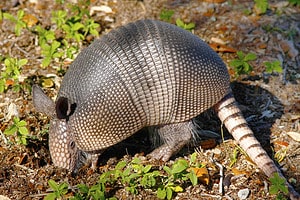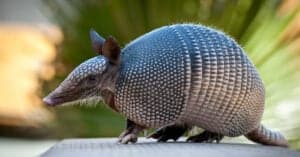The armadillo is one of the strangest little creatures found in the Americas. Its name in Spanish translates to “little armored one,” and refers to its armored shell made up of dermal bone. In total, there exist 21 known species of armadillo, all of which live in North America and South America. Most species live in temperate, warmer habitats ranging from rain forests to grasslands to deserts. They range in size from around 5 to 6 inches long to nearly 59 inches long. One species, Tolypeutes, exhibits a unique behavior in that it can roll into a ball when threatened. Armadillos feature prominently in American literature, arts, and culinary traditions. Additionally, they have been used extensively in scientific research. This is due to the fact that they are one of the few animals known to contract leprosy. Still, do you know the answer to the question, “what do armadillos eat?”
In this article, we’ll attempt to answer all of your questions concerning what armadillos eat. We’ll start off with a general overview of what armadillos generally like to eat. Next, we’ll discuss how they go about hunting and foraging for food. Then, we’ll compare what they eat in the wild versus what they eat in captivity. Finally, we’ll end with a brief discussion of what baby armadillos eat. So, let’s get this conversation rolling as we answer the question, “what do armadillos eat?”
What Do Armadillos Like to Eat?
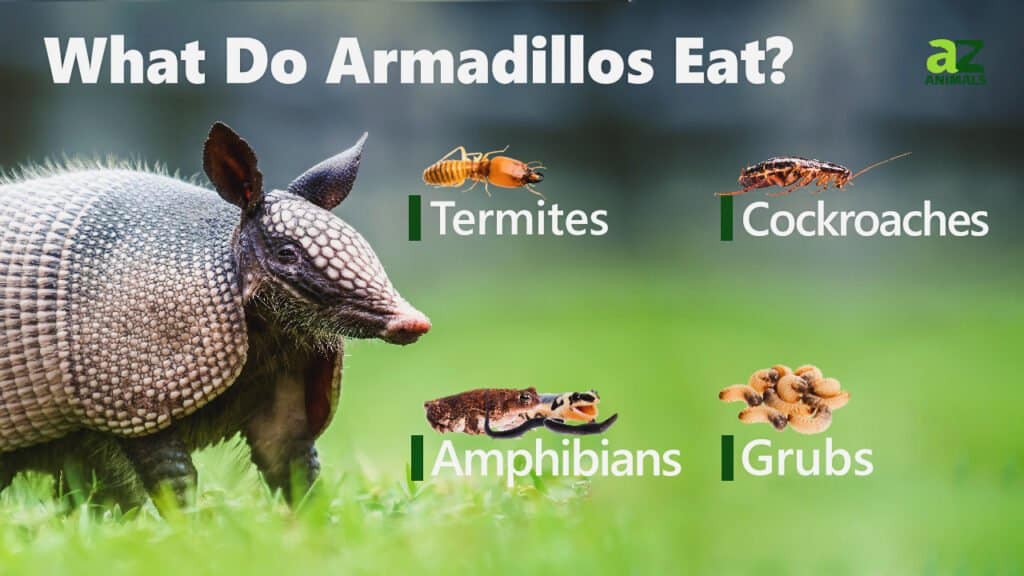
Armadillos are omnivores, meaning that they eat both plant and animal matter. That being said, insects make up the bulk of their diet and may constitute nearly 90% of what they eat. However, there exists a lot of variance in the dietary habits between different armadillo species. While some armadillos eat a wide variety of food, others are specialist hunters, preferring to dine on just a few different prey animals. Although they prefer live prey, armadillos are not opposed to eating carrion as well. As opportunistic eaters who eat both plants and animals, an armadillo will end up eating just about anything. For the purposes of this article, we’ve identified 10 foods that most armadillos like to eat. This is not to say that all armadillos eat these foods, simply that they occur frequently in an armadillo’s diet. The 10 foods that armadillos like to eat include:
- Insects
- Grubs
- Invertebrates
- Small reptiles
- Mushrooms
- Vegetables
- Fruits
- Seeds
- Eggs
- Small amphibians
How Do Armadillos Hunt and Forage For Food?
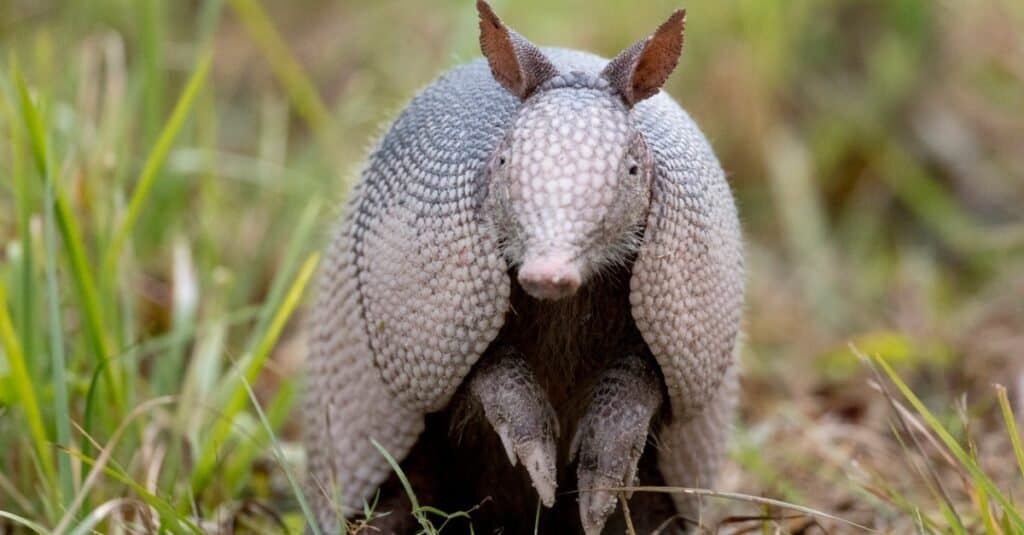
Armadillos are prolific diggers and are experts at finding insects under the soil.
©iStock.com/6381380
When hunting and foraging, armadillos rely on their senses to help them find food. That said, they use some senses more than others. For example, armadillos possess very poor eyesight. This makes sense, given that most armadillos are nocturnal. As a result, they mostly rely on their keen sense of smell to find food. While hunting for food, they can smell prey and other morsels located nearly 8 inches below the ground. Meanwhile, they also have strong hearing abilities, although they mostly rely on their hearing to avoid predators. Additionally, armadillos are equipped with long hairs on their undersides. These long hairs act like the whiskers on a cat and are very sensitive to touch. They allow an armadillo to closely feel the environment they are walking on. This helps them to detect food, and also to locate suitable areas for them to dig.
Armadillos mostly find food by digging through dirt and soil. They are prolific diggers, and use their sharp claws to sift through the ground to find food. An armadillo can dig out a burrow in about 15 minutes, so it can quickly find food located a few inches below ground. They possess 5 claws on their hind feet, and between 3 to 5 claws on their forefeet. The claws on their forefeet are thicker and heavier, which makes them perfect for digging. Unlike most other mammals, armadillos do not have canine or incisor teeth. Instead, they continuously grow peg-like teeth, of which they possess between 14 to 18 per jaw. When not sleeping, armadillos are usually hunting or foraging. They do the majority of their hunting at dusk and dawn when insects are usually most active.
What Do Armadillos Eat in the Wild?
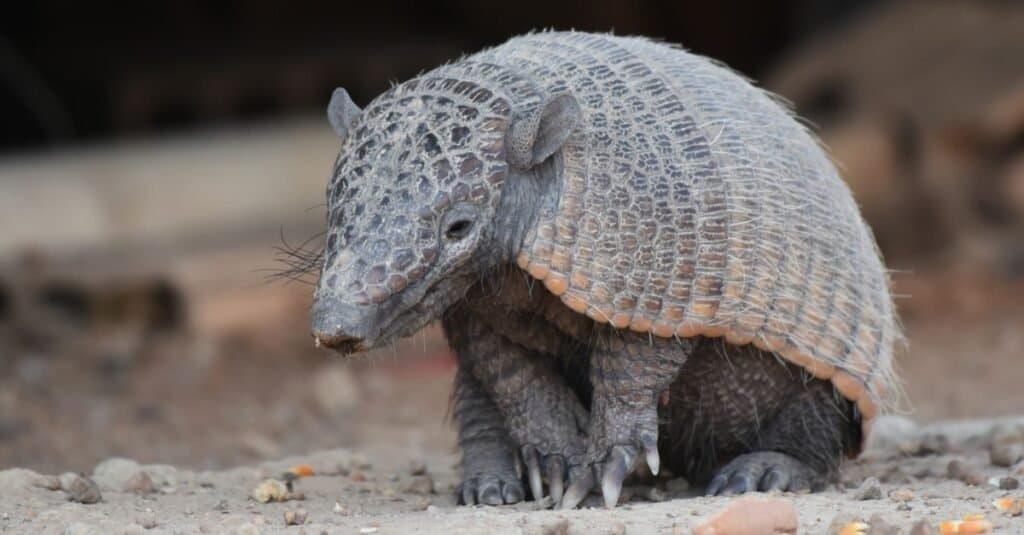
Armadillos are opportunistic eaters that will eat pretty much anything they can find, although some species will eat almost exclusively ants and termites.
©iStock.com/Rini Kools
In the wild, armadillos will eat just about anything that they can catch or find. As opportunistic eaters, they aren’t particularly picky, although certain species do show preferences toward particular foods. For example, while most armadillos eat insects, grubs, and invertebrates, some specifically target ants and termites. Other insects that armadillos eat include cockroaches, grasshoppers, beetles, and wasps. Additionally, they will also eat spiders, scorpions, and snails. Along with insects and invertebrates, wild armadillos will also target bird and reptile eggs. On occasion, they will even eat small reptiles and amphibians such as snakes and frogs. As for plants, armadillos eat a wide variety of plants including mushrooms, fruits, vegetables, and seeds. In total, armadillos have been reported eating over 500 different foods. When available, they will also eat carrion, although they tend to prefer live prey. That said, they’ll never turn down an easy meal.
What Do Captive Armadillos Eat?
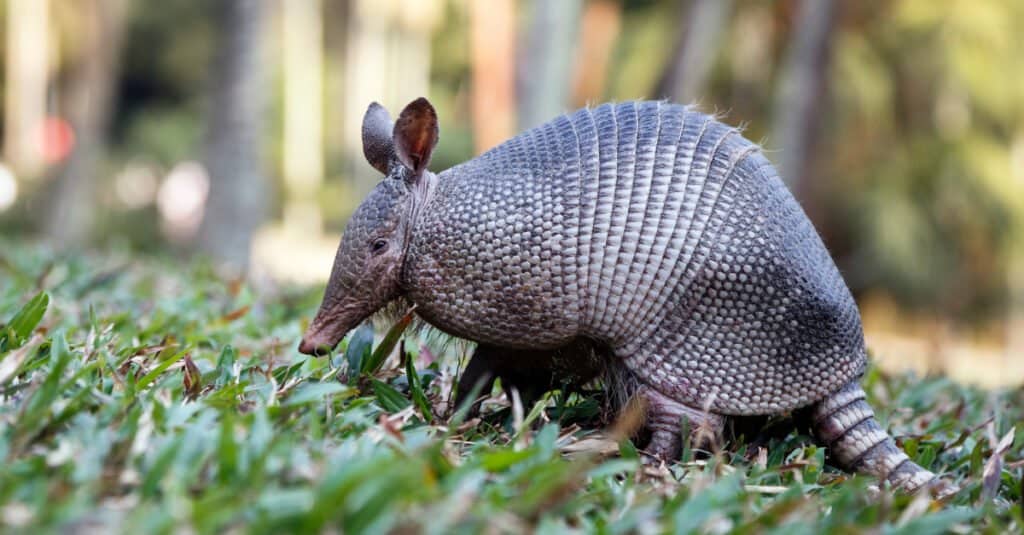
Some armadillos can eat up to 200,000 ants in a single day.
©Klaus Balzano/Shutterstock.com
Armadillos do not make good pets and it is illegal to own an armadillo as a pet in many places. However, they are still commonly kept in zoos, where people enjoy watching these unique creatures in synthetic habitats. Most zoos feed captive armadillos a predominantly insectivorous diet. This diet includes a number of different insects including grasshoppers, ants, termites, beetles, and grubs. Along with insects, many zoos also feed their captive armadillos a limited amount of fruit. However, depending on the species, some armadillos may require a more specific diet. For example, giant armadillos, southern three-banded armadillo, and pink fairy armadillos mostly eat ants and termites. These animals require a large number of insects to stay well fed. Just one giant armadillo can eat up to 200,000 ants in a single day. Such a large number of insects means that caring for these giant creatures can be difficult.
What Do Baby Armadillos Eat?

Armadillos typically have large litters, and the babies are called pups.
©Rose Waddell/Shutterstock.com
Most armadillos live between 7 and 20 years in the wild, but they can live longer in captivity. Baby armadillos are called pups. A female armadillo can give birth to anywhere from 1 to 12 pups at a time, depending on the species. Meanwhile, the nine-banded armadillo almost always gives birth to identical quadruplets. At birth, the pups possess soft, leathery shells rather than hard shells. On average, the mother will nurse the pups for between 2 to 4 months, but this can vary depending on the species. Once the pup is old enough, it will begin to eat the same food as an adult armadillo. By around 9 to 12 months old, armadillos are fully mature and venture out on their own.
Should I Worry About Armadillos in My Yard?
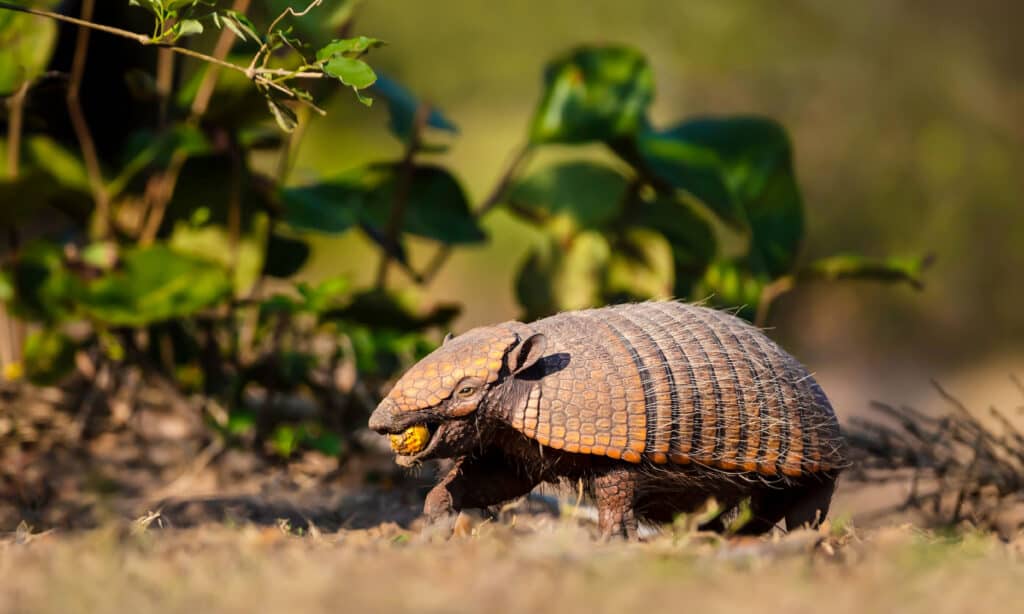
Armadillos can wreak havoc in your yard or garden, given their digging and tunneling behaviors.
©Giedriius/Shutterstock.com
If an armadillo has wandered onto your property, it can be both beneficial and a nuisance. On the upside, armadillos consume insects, sometimes unwanted ones like ants or termites. But their process to acquire whatever insect their hunting is where the problems pile up. Their digging behavior can damage and even destroy flower beds, gardens, and lawns. Armadillos will even tunnel under driveways, foundations, and other structures in their zest for food.
These creatures also can carry diseases that are potentially harmful to pets or people. If you are active in your yard and find that an armadillo is disrupting the delicate balance around your home, one deterrent is a castor oil-based repellant, which is a safe but effective agent that seeps into the soil to contaminate their food sources, rendering it unappetizing. Another effective strategy to ward off armadillos is to remove excess brush or woodpiles, which tend to attract insects and other small animals that they these diggers eat.
The photo featured at the top of this post is © Heiko Kiera/Shutterstock.com
Thank you for reading! Have some feedback for us? Contact the AZ Animals editorial team.




